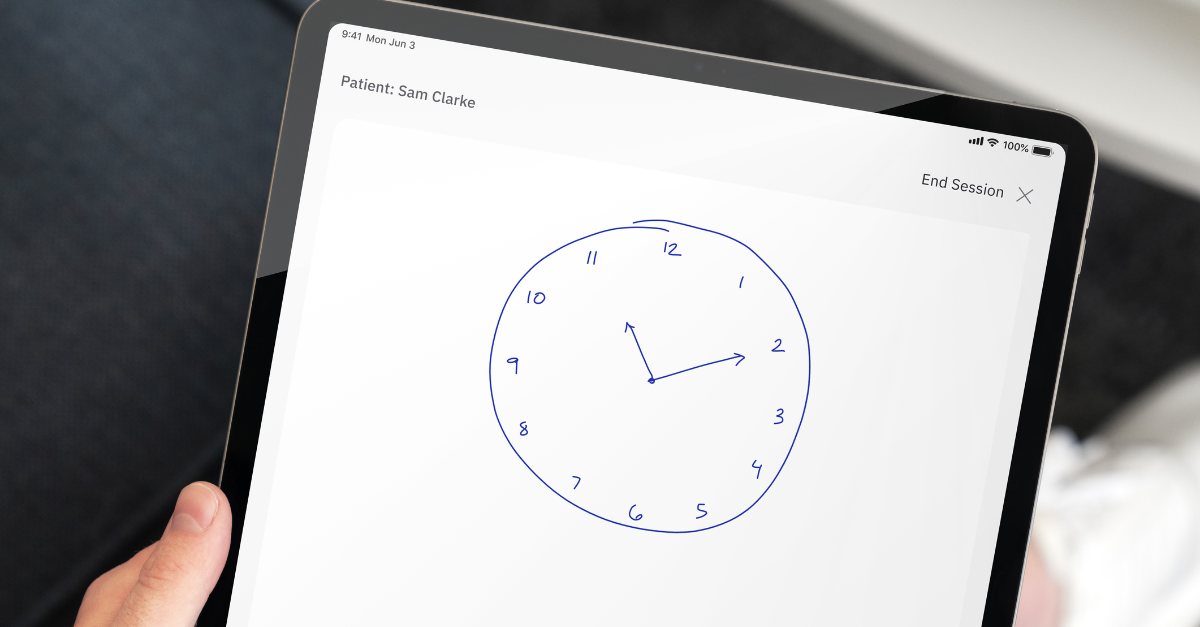The Clock Drawing Test (CDT) is a long-trusted and thoroughly studied cognitive assessment tool. Also commonly referred to as the dementia clock test, it asks people to draw two clocks – one copied, the other from memory.
Over 100 years of development and study have contributed to the test in use today. In recent years, digital innovations have improved the efficiency and scalability of the CDT significantly. The Linus Health platform goes a huge step further, using artificial intelligence to uniquely analyze a person’s process of drawing the clocks, not just the final output. Our proprietary cognitive assessment, the Digital Clock and Recall (DCR™):
- is available to administer quickly and easily via an iPad
- objectively measures cognitive function across multiple domains
- detects early signs of cognitive impairment - even those invisible to the human eye
Today we look at how the clock drawing test, commonly referred to as the dementia clock test, evolved to become a digital solution that’s changing the landscape of brain health.
It wasn’t always the dementia clock test
The Parietal Lobes, by MacDonald Critchley (1953) is often cited as the first mention of the CDT. However, the test actually dates back to at least 1915.
Originally, the test assessed soldiers who had suffered head wounds. Doctors were testing for apraxia and aphasia-related disorders. They asked soldiers to draw a clock in large part because of its complexity. To draw a clock correctly, a person needs to follow directions, understand language, visualize proper orientation of an object, and execute normal movements.
As the 20th century progressed, clinicians increasingly used the CDT to test cognitive function. Until a paper published by Dr. Edith Kaplan in 1988 revolutionized the approach and led to widespread adoption.
A process-based approach to cognitive testing
While working at the Boston VA Medical Center (BVAMC), Dr. Kaplan standardized the CDT to involve two components:
- copying a clock shown
- drawing a clock from memory
Kaplan also discovered that the process people go through to complete the test, including errors they make along the way, can be assessed to identify signs of cognitive dysfunction. This innovation was named the Boston Process Approach (BPA). She later refined the process by introducing a CDT with the hands set to “ten after eleven o’clock.” This assessed long-term attention, memory, auditory processing, and motor programming.
Digital innovation to the clock drawing test
In the late 20th century, two new, paper-based cognitive tests rose to prominence. These were the Montreal Cognitive Assessment (MoCA) and the Mini-Cog. Both used the CDT but neither incorporated the BPA for analysis and scoring.
The BPA helps providers and researchers glean insights about cognitive function and detect subtle signs of mild cognitive impairment. It historically relied on direct observation by highly trained neuropsychologists to monitor and analyze the person’s process of completing cognitive tasks. 21st century innovations in digital technology have changed this.
DCTclock™ was created to make the BPA more accessible and scalable for widespread use in clinical practice using digital tools. Created in 2005 by Dr. Dana Penney of Lahey Health and Dr. Randall Davis of the Massachusetts Institute of Technology, it originally used specialized paper and a camera to record the process, and a remote server for analysis. Numerous studies have proved that this digital clock drawing test is an effective way to evaluate cognitive function.
The Linus Health Platform
Since 2019, Linus Health has been improving brain health on a global scale by expanding the reach and impact of its foundational digital clock drawing test. The platform is unique as Linus Health holds the patent for using the BPA in clock drawing tests. Linus Health’s successor digital cognitive assessment to the DCTclock - the Digital Clock and Recall (DCR™) builds on the DCTclock with the addition of word recall components.
Today, it’s quick and easy for clinicians to assess patients for mild cognitive impairment using the power of Linus’ digital solutions. They can easily administer the DCR via iPad and Apple pencil. And results are immediate and objective. Also offering features to make it easier for providers to coach patients on evidence-based lifestyle interventions, the Linus Health platform is a novel and actionable tool for helping combat the cognitive care crisis.
Read about our approach, to find out more about how we’re helping providers detect the early signs of cognitive impairment and intervene early to improve brain health outcomes.
